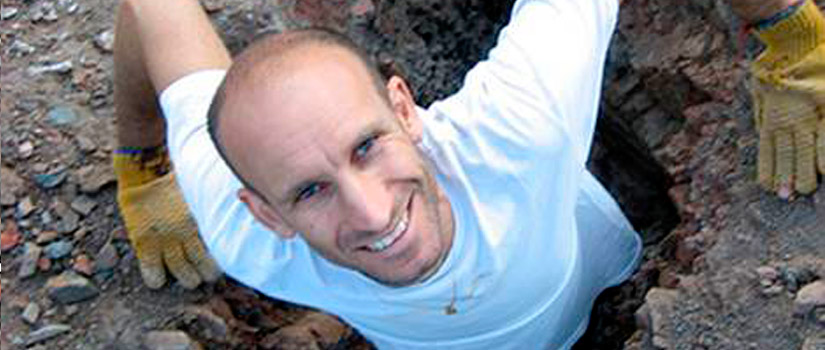UNCOVERING A DEEP-SEATED AMBITION
WHILE DIGGING A TRENCH.
WELL, SORT OF.
Curtis Seltzer
When my mother gave 14-year-old me my daily dose of advice that would help me in the future, she said: “I don’t care if you end up as a ditch-digger, just be a good one.”
Clearly, she was trying to keep my career expectations in line with what she saw in front of her. In her mind, ditch-digging was the most menial job she could imagine. She must have been trying to raise my sights.
I’ve considered making a living from manual labor from time to time. I’ve built houses and learned a few skills. I know a bit about small-scale logging. And 37 years ago I was qualified to be an apprentice underground coal miner in West Virginia. No one hired me, which was undoubtedly a good thing for all concerned.
Truth be told, I’ve never known a ditch-digger. By the early 1960s, pick-and-shovelers were obsolete and unemployed. The backhoe–a rubber-tired tractor with a scoop bucket in front and a digging arm in back–was more productive and cost-efficient than any team of hand-laborers.
So I entered the ditch-digging vocation relatively late and was never properly mentored. I’ve had to pick it up as I’ve gone along. The ditches I’ve dug have always been for my own use.
Digging a ditch requires more than strength and stamina. The digger has to keep his eye on the depth of the trench, its width and–for water and sewerage lines–its pitch from one end to the other. (You don’t want a black-water waste pipe sloping upward–or even level–from its point of origin.)
On big projects, engineering drawings show ditch dimensions, slopes, pitches and depths. On small-farm projects, you generally rely on eye and feel. Technically savvy farmers like me may even use a retractable tape measure.
The last step in buttressing the front wall of our mid-1940s, two-story, 100-foot-long cinderblock barn was removing the earth piled against the lower level and installing a drainage system to keep water away from the front of the barn.
In fixing the buckling wall, I discovered that the building did not rest on a conventional 12-inch wide foundation. To save money, the blocks had been laid on a stone-and-cement mixture that was no wider than the 8-inch wide block itself. This stuff was now crumbling, leaving the wall supported by nothing more than fading memories.
To save more money, the builder had used cheap cinderblocks rather than heavier and more expensive concrete blocks. To save even more money, no drain tile had been installed on the fill side of the wall. And to save even more money than that, the earth and rocks that had been dug out by hand in the mid-1940s to make a level building pad had been stuffed back against the wall rather than hauled off.
It had taken about six weeks of part-time labor to erect a system of poles and planks on the inside of the barn’s lower level to buttress the cinderblock wall. The final step was digging out the fill and ditching in a drain pipe.
Even were I younger, stronger and crazier, I would not have excavated the fill and the 170-foot-long drainage trench by hand. I did, however, consider it, which should not be taken to mean that I’m either young or strong.
Digging is slow, contemplative work. It’s annoying only when you’re trying to make it go fast. Digging should be quiet, pleasant and stress-free. Done right, it’s also therapeutic.
That said, a local contractor’s backhoe did the digging.
Now, the 77-year-old backhoe excavator is a highly skilled individual. He and I had done similar jobs before. I always marvel at his touch with heavy equipment. He worked against the block wall without touching it. He dug a properly pitched trench without measuring, wasting no effort.
Being highly unskilled, I assigned myself the sweaty grunt work, which got me to thinking about both Ibuprofen and ambition, in that order.
For whatever reasons, I’ve never thought that making a lot of money was the right objective of my ambition. Perhaps my mother would have done better to tell me: “I don’t care if you end up running a $500 billion hedge fund, just stay out of jail.”
In college and graduate school in the ’60s and ’70s, I deliberately rejected money-grubbing, as did many contemporaries. I didn’t want to end up as a Mad Man. As I moved into my 50s and 60s, grubbing around for money became more necessary, which has made it somewhat more appealing.
I’m now sure that it’s better to err on the side of ambition than its opposite–slacking. But shouldn’t ambition be defined as more than just money?
As I cleaned up my newest ditch, I found myself thinking that ambition should include producing something that has value for both you and, in the best of circumstances, others. Above all, it should be married polygamously to the ideas of doing a good job, acting with defensible ethics and generating some satisfaction, as in happy self-esteem.
It turns out that ditch-digging fulfills all the goals I’ve set for ambition. Perhaps I should start digging ditches for others, now that I’ve dug several deep ones for myself.
Curtis Seltzer is a writer and land consultant who lives on a cattle-and-timber farm in Blue Grass, Va. He is the author of How To Be A Dirt-Smart Buyer of Country Property and four collections of his columns at www.curtis-seltzer.com. He can be reached at curtisseltzer@htcnet.org.



